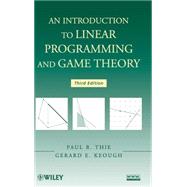
Note: Supplemental materials are not guaranteed with Rental or Used book purchases.
Purchase Benefits
What is included with this book?
PAUL R. THIE, PhD, is Professor Emeritus in the Department of Mathematics at Boston College. Dr. Thie has authored numerous journal articles in the areas of mathematical programming and several complex variables.
GERARD E. KEOUGH, PhD, is Associate Professor and former chair of the Department of Mathematics at Boston College. He has written extensively on operator theory, functional analysis, and the use of technology in mathematics. Dr. Keough is the coauthor of Getting Started with Maple®, Second Edition and Getting Started with Mathematica®, Second Edition,both published by Wiley.
| Preface | p. xi |
| Mathematical Models | p. 1 |
| Applying Mathematics | p. 1 |
| The Diet Problem | p. 2 |
| The Prisoner's Dilemma | p. 5 |
| The Roles of Linear Programming and Game Theory | p. 8 |
| The Linear Programming Model | p. 9 |
| History | p. 9 |
| The Blending Model | p. 10 |
| The Production Model | p. 21 |
| The Transportation Model | p. 34 |
| The Dynamic Planning Model | p. 38 |
| Summary | p. 47 |
| The Simplex Method | p. 57 |
| The General Problem | p. 57 |
| Linear Equations and Basic Feasible Solutions | p. 63 |
| Introduction to the Simplex Method | p. 72 |
| Theory of the Simplex Method | p. 77 |
| The Simplex Tableau and Examples | p. 85 |
| Artificial Variables | p. 93 |
| Redundant Systems | p. 101 |
| A Convergence Proof | p. 106 |
| Linear Programming and Convexity | p. 110 |
| Spreadsheet Solution of a Linear Programming Problem | p. 115 |
| Duality | p. 121 |
| Introduction to Duality | p. 121 |
| Definition of the Dual Problem | p. 123 |
| Examples and Interpretations | p. 132 |
| The Duality Theorem | p. 138 |
| The Complementary Slackness Theorem | p. 154 |
| Sensitivity Analysis | p. 161 |
| Examples in Sensitivity Analysis | p. 161 |
| Matrix Representation of the Simplex Algorithm | p. 175 |
| Changes in the Objective Function | p. 183 |
| Addition of a New Variable | p. 189 |
| Changes in the Constant-Term Column Vector | p. 192 |
| The Dual Simplex Algorithm | p. 196 |
| Addition of a Constraint | p. 204 |
| Integer Programming | p. 211 |
| Introduction to Integer Programming | p. 211 |
| Models with Integer Programming Formulations | p. 214 |
| Gomory's Cutting Plane Algorithm | p. 228 |
| A Branch and Bound Algorithm | p. 237 |
| Spreadsheet Solution of an Integer Programming Problem | p. 244 |
| The Transportation Problem | p. 251 |
| A Distribution Problem | p. 251 |
| The Transportation Problem | p. 264 |
| Applications | p. 282 |
| Other Topics in Linear Programming | p. 299 |
| An Example Involving Uncertainty | p. 299 |
| An Example with Multiple Goals | p. 306 |
| An Example Using Decomposition | p. 314 |
| An Example in Data Envelopment Analysis | p. 325 |
| Two-Person, Zero-Sum Games | p. 337 |
| Introduction to Game Theory | p. 337 |
| Some Principles of Decision Making in Game Theory | p. 345 |
| Saddle Points | p. 350 |
| Mixed Strategies | p. 353 |
| The Fundamental Theorem | p. 360 |
| Computational Techniques | p. 370 |
| Games People Play | p. 382 |
| Other Topics in Game Theory | p. 391 |
| Utility Theory | p. 391 |
| Two-Person, Non-Zero-Sum Games | p. 393 |
| Noncooperative Two-Person Games | p. 397 |
| Cooperative Two-Person Games | p. 404 |
| The Axioms of Nash | p. 408 |
| An Example | p. 414 |
| Vectors and Matrices | p. 417 |
| An Example of Cycling | p. 421 |
| Efficiency of the Simplex Method | p. 423 |
| LP Assistant | p. 427 |
| Microsoft Excel and Solver | p. 431 |
| Bibliography | p. 439 |
| Solutions to Selected Problems | p. 443 |
| Index | p. 457 |
| Table of Contents provided by Ingram. All Rights Reserved. |
The New copy of this book will include any supplemental materials advertised. Please check the title of the book to determine if it should include any access cards, study guides, lab manuals, CDs, etc.
The Used, Rental and eBook copies of this book are not guaranteed to include any supplemental materials. Typically, only the book itself is included. This is true even if the title states it includes any access cards, study guides, lab manuals, CDs, etc.